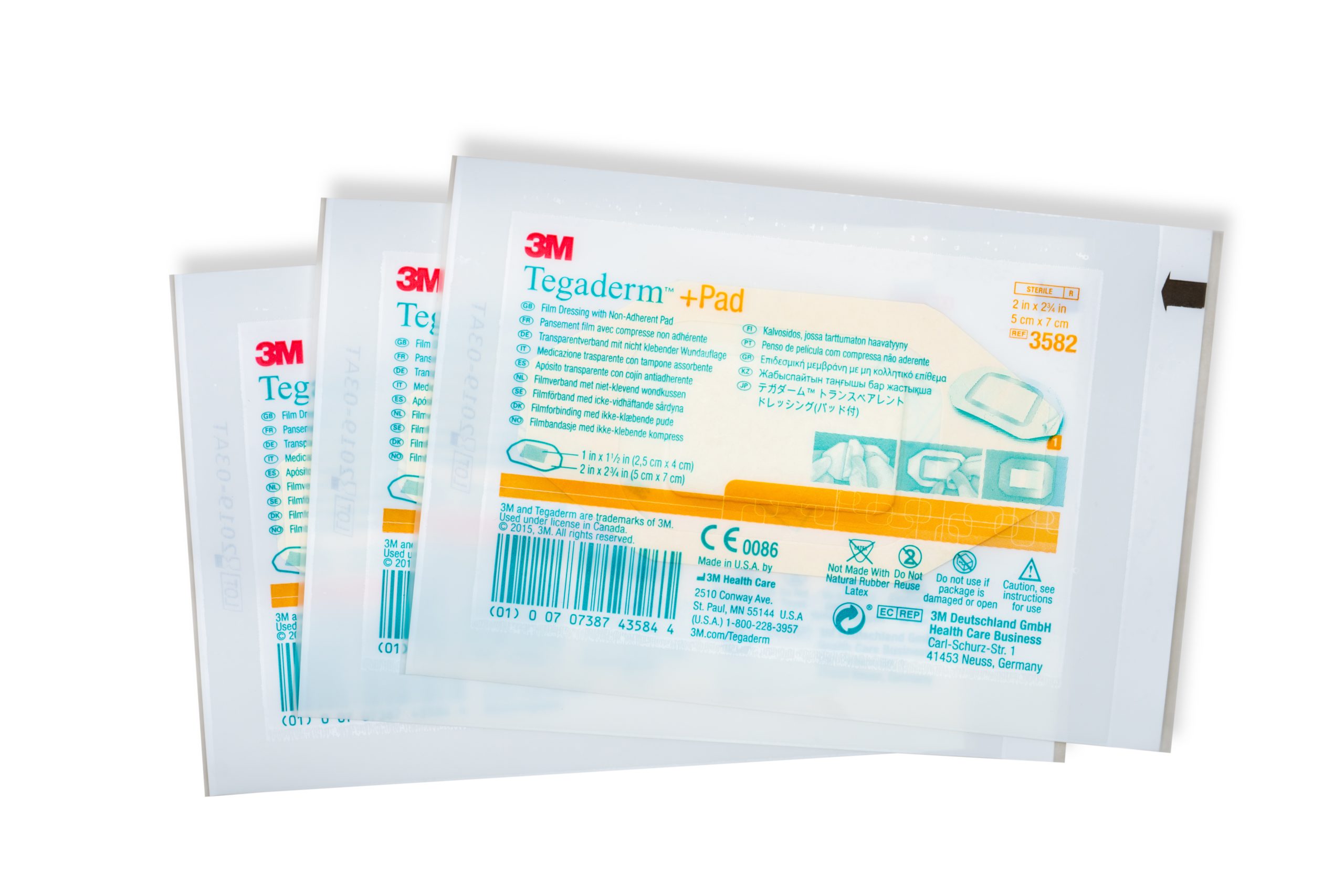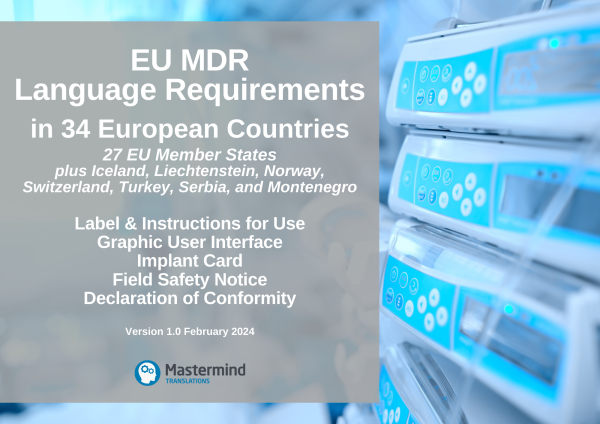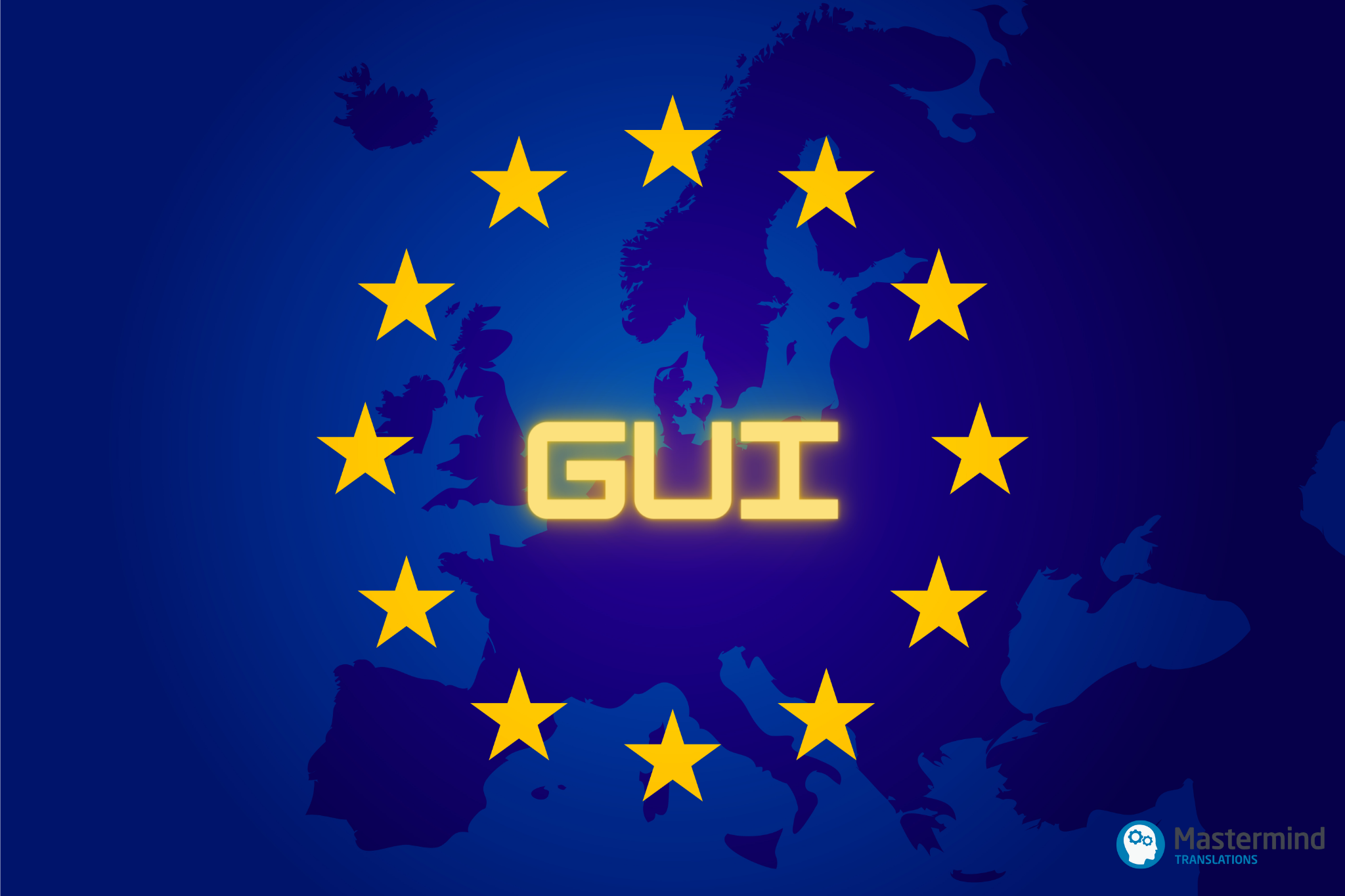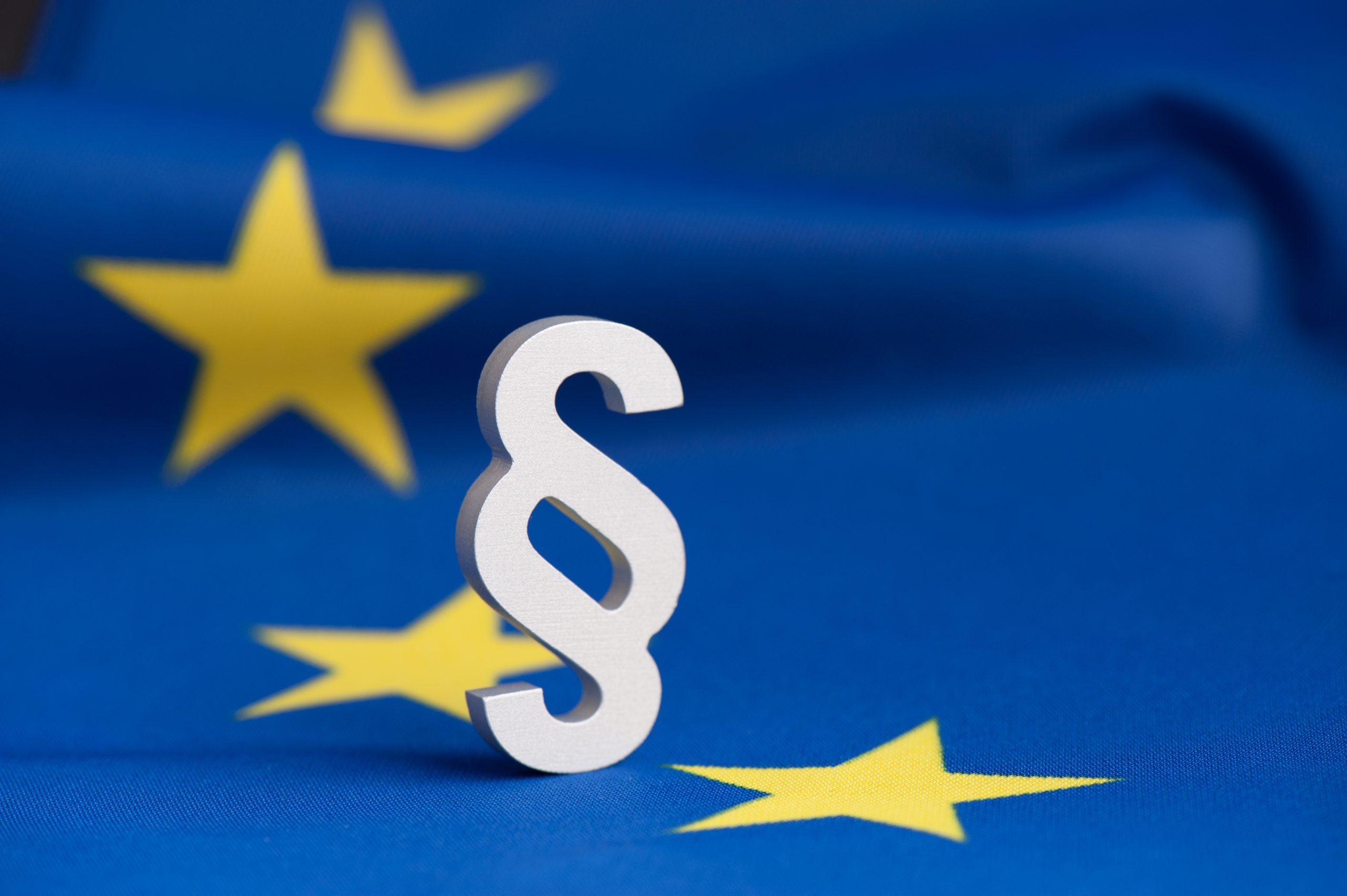Medical device manufacturers who make their products available to users in EU Members States must meet stringent language requirements set out by the European Union Medical Devices Regulation (EU MDR) for the information supplied with their device. In this article, we break down the critical aspects of those translation requirements for labels and discuss effective practices for ensuring compliance, patient safety, and market success.
What Is a Label of a Medical Device Under the EU MDR?
Article 2(13) defines the ‘label’ of a medical device as:
EU MDR, Article 2(13)
‘label’ means the written, printed or graphic information appearing either on the device itself, or on the packaging of each unit or on the packaging of multiple devices;
In addition, Article 10(11) obligates manufacturers to ensure that the particulars on the label are indelible, easily legible and clearly comprehensible to the intended user, regardless of whether they are a healthcare professional or a lay user.
What Information Should Appear on the Label?
Section 23.2 specifies that the label should include the following information, as applicable:
EU MDR, Annex I Chapter III Section 23.2
The label shall bear all of the following particulars:
(a) the name or trade name of the device;
(b) the details strictly necessary for a user to identify the device, the contents of the packaging and, where it is not obvious for the user, the intended purpose of the device;
(c) the name, registered trade name or registered trade mark of the manufacturer and the address of its registered place of business;
(d) if the manufacturer has its registered place of business outside the Union, the name of the authorised representative and address of the registered place of business of the authorised representative;
(e) where applicable, an indication that the device contains or incorporates:
— a medicinal substance, including a human blood or plasma derivative, or
— tissues or cells, or their derivatives, of human origin, or
— tissues or cells of animal origin, or their derivatives, as referred to in Regulation (EU) No 722/2012;
(f) where applicable, information labelled in accordance with Section 10.4.5.;
(g) the lot number or the serial number of the device preceded by the words LOT NUMBER or SERIAL NUMBER or an equivalent symbol, as appropriate;
(h) the UDI carrier referred to in Article 27(4) and Part C of Annex VII;
(i) an unambiguous indication of the time limit for using or implanting the device safely, expressed at least in terms of year and month, where this is relevant;
(j) where there is no indication of the date until when it may be used safely, the date of manufacture. This date of manufacture may be included as part of the lot number or serial number, provided the date is clearly identifiable;
(k) an indication of any special storage and/or handling condition that applies;
(l) if the device is supplied sterile, an indication of its sterile state and the sterilisation method;
(m) warnings or precautions to be taken that need to be brought to the immediate attention of the user of the device, and to any other person. This information may be kept to a minimum in which case more detailed information shall appear in the instructions for use, taking into account the intended users;
(n) if the device is intended for single use, an indication of that fact. A manufacturer’s indication of single use shall be consistent across the Union;
(o) if the device is a single-use device that has been reprocessed, an indication of that fact, the number of reprocessing cycles already performed, and any limitation as regards the number of reprocessing cycles;
(p) if the device is custom-made, the words ‘custom-made device’;
(q) an indication that the device is a medical device. If the device is intended for clinical investigation only, the words ‘exclusively for clinical investigation’;
(r) in the case of devices that are composed of substances or of combinations of substances that are intended to be introduced into the human body via a body orifice or applied to the skin and that are absorbed by or locally dispersed in the human body, the overall qualitative composition of the device and quantitative information on the main constituent or constituents responsible for achieving the principal intended action;
(s) for active implantable devices, the serial number, and for other implantable devices, the serial number or the lot number.
How Does the MDR Differentiate Between Instructions for Use and the Label?
The MDR makes a clear distinction between the label and instructions for use. Labels are affixed directly to the device or, if it is not practicable or appropriate, on its packaging. They must include essential information, such as that needed to identify the device and its manufacturer, its intended purpose, warnings or precautions, or details of any special storage and/or handling condition. Instructions for use, on the other hand, provide more detailed operational guidance and are often included as separate documents (called ‘IFUs’, or more colloquially ‘manuals’).
According to Section 23.1, the location of instructions for use should be appropriate to the particular device, its intended purpose and the technical knowledge, experience, education or training of the intended user(s). This means that this information may also appear on the device alongside the information that falls under the defininiton of ‘label’. This practice is common for Class I or II devices, such as contact lenses or disinfectant wipes. Where there is no IFU supplied separately, the label is the only guidance on how to use the device safely and correctly.
It is worth clarifying that the term ‘product labelling’ (or ‘product labeling’ in the USA), sometimes used in the context of medical technologies, typically refers to all written, printed, or graphic information that accompanies a device. This includes not only the label affixed to the device itself but also any additional information provided in its IFU or graphical user interface (GUI). However, the MDR does not use this term and instead refers collectively to this information as ‘information supplied by the manufacturer with the device’.
What Are the Language Requirements for Medical Device Labels?
The label falls under what is referred to in Annex I Chapter III Section 23.1 as the information supplied by the manufacturer with the device. Article 10(11) mandates that this information must be provided in an official language(s) of the EU accepted in the national markets.
EU MDR, Article 10(11)
Manufacturers shall ensure that the device is accompanied by the information set out in Section 23 of Annex I in an official Union language(s) determined by the Member State in which the device is made available to the user or patient.
This means that the label must be translated into the national language of each of EU Member States where the device is placed. Individual Member States establish their language selection through supplementary national medical device legislation and/or official guidelines issued by their competent authorities (CAs). Their choice of language(s) may also vary, depending on the device class and intended user. To support faster new market entry and reduce translation burdens, some European countries offer exemption from their national language requirements for devices intended for healthcare professionals.
In January 2024, the European Commission released two tables summarising the linguistic requirements for manufacturers of medical devices under the EU MDR and IVDR, which also include the languages accepted for the label across the 30 European Economic Area (EEA) countries.
Similar linguistic rules apply to in vitro diagnostics (IVDs) under the EU IVDR 2017/746.
How Are Symbols Used on the Label?
To reduce the need for extensive translation and save labelling space, Section 23.1(h) permits the use of internationally recognised symbols as a graphical representation appearing on the label as an alternative to text.
EU MDR, Annex I Chapter III Section 23.1(h)
Where appropriate, the information supplied by the manufacturer shall take the form of internationally recognised symbols. Any symbol or identification colour used shall conform to the harmonised standards or CS. In areas for which no harmonised standards or CS exist, the symbols and colours shall be described in the documentation supplied with the device.
ISO 15223-1:2021 – Medical devices — Symbols to be used with information to be supplied by the manufacturer — General requirements is the primary standard that defines internationally recognised symbols used for medical devices.
How to Ensure Accurate Translation of Labels for Medical Devices?
To ensure that the translation of information on their product labels is accurate, manufacturers should partner with a life science translation provider who has experience in translating information supplied with medical devices aimed at Europe. It is essential to choose a partner who adheres to ISO 17100:2015 Translation Services-Requirements for Translation Services, which guarantees that all translations meet quality assurance standards and regulatory requirements.
What Are Key Challenges in Translating Labels for Medical Devices?
Translating labels for medical devices involves more than just ensuring language accuracy — it requires navigating challenges, such as limited context and space, as well as maintaining consistency across multiple product ranges, product information updates, and export markets. Let’s look at the three main challenges:
1 Low Context
Labels of medical devices often contain highly technical information presented in a very concise form. This brevity provides very little context for linguists, making it difficult to interpret the meaning behind certain terms or phrases accurately.
For example, a single word on a label might refer to a highly complex medical procedure, but without additional context, translating it could result in ambiguity. This is particularly challenging with multiple languages, where words or terms may not have direct equivalents. To overcome this, it is critical for the translation team to have access to background information and a clear understanding of the device’s function.
2 Space Constraints
Labels are physically limited in space, making it difficult to fit translations of the required information. This is especially a challenge when translating into languages that are more verbose than the original. For example, German and French typically require 30% more characters than English, potentially leading to layout issues in the artwork.
To address space constraints, manufacturers often rely on the use of symbols, which reduce the need for text-based translations. However, when text is necessary, translations must be both concise and clear without losing the meaning of the original message. Achieving this balance is a complex task that requires linguistic skill and a deep understanding of the device’s usage. Access to sample artwork is essential for this process.
3 Consistency
Maintaining consistency is by far the biggest challenge in medical device translation. Here are key considerations:
Product Ranges
Medical device manufacturers often have multiple product lines, each with slight variations in features and applications. It is essential to ensure uniform terminology and wording across labels for similar products within the same range. This will help avoid confusion among users and reinforce brand integrity.
Product Information Updates
Medical devices, especially in lower-risk classes, frequently undergo updates to their specifications and characteristics. When labels are revised, the updated wording should be applied consistently across all versions and languages. This requires a systematic approach to version management to ensure that changes are accurately reflected based on legacy translations.
Other Information Supplied with the Device
In addition to labels, medical device manufacturers must consider all other information supplied with their device, such as the IFU and/or fact sheets. Consistency in terminology across all forms of information is essential to provide clear guidance and easy reference to users. Ensuring that the same wording is used in the label and other user-facing material will help avoid confusion and enhance user understanding.
Regulated or Official Terminology
Certain terms in the medical device industry are governed by regulatory bodies and must be translated using specific official terminology. For instance, the use of H-phrases and P-phrases requires adherence to established translations to ensure compliance across the European Union. This also applies to any wording taken from the MDR, which has 24 official language versions.
There are several effective strategies and technologies to address the challenges of maintaining consistency in label translation.
To ensure uniformity across different labels, translation memories (TM) are employed. A TM is a database that stores previously translated text, allowing linguists to reuse it for new labels, even when the new wording slightly differs from the original.
Glossaries are curated lists of terms specific to a particular project or medical device company, providing definitions and context. They serve as essential reference tools for linguists, ensuring that specific terminology is consistently applied across all translations. These glossaries can be centralised in terminology management software and integrated with TMs, enabling translators to access them in real time.
Query logs are records of questions or uncertainties that arise during the translation process. They help track instances where translators seek clarification on specific terms or phrases. By maintaining a log of these queries, team members can communicate more efficiently, using a central point of reference for resolving terminology issues.
Best Practices for Medical Device Label Translation
- Understand the MDR Translation Requirements
Familiarise yourself with the language rules applicable to your device in your chosen EU countries. - Implement a Robust Version Control System
Establish a systematic version control process in your Quality Management System (QMS) to track changes in labels and corresponding IFUs. - Work with a Translation Company Experienced in Medical Devices
Choose a language service provider with proven expertise in medical device translation services. Their knowledge of regulatory requirements and industry-specific medical terminology will enhance the accuracy and regulatory compliance of your labels. - Support Your Translation Provider
Provide your translation partner with access to previous translations, reference materials, background information, and label artwork. - Allow Sufficient Time for Project Completion
Allocate adequate time for translation and review processes. Rushed projects can lead to errors and oversights.
Please note that the information provided in this article is for guidance only and does not constitute professional regulatory advice. In the case of specific questions related to compliance with EU MDR and IVDR, we recommend that manufacturers shall seek assistance from a QA/RA specialist and/or the CA of the country where the device is sold.







